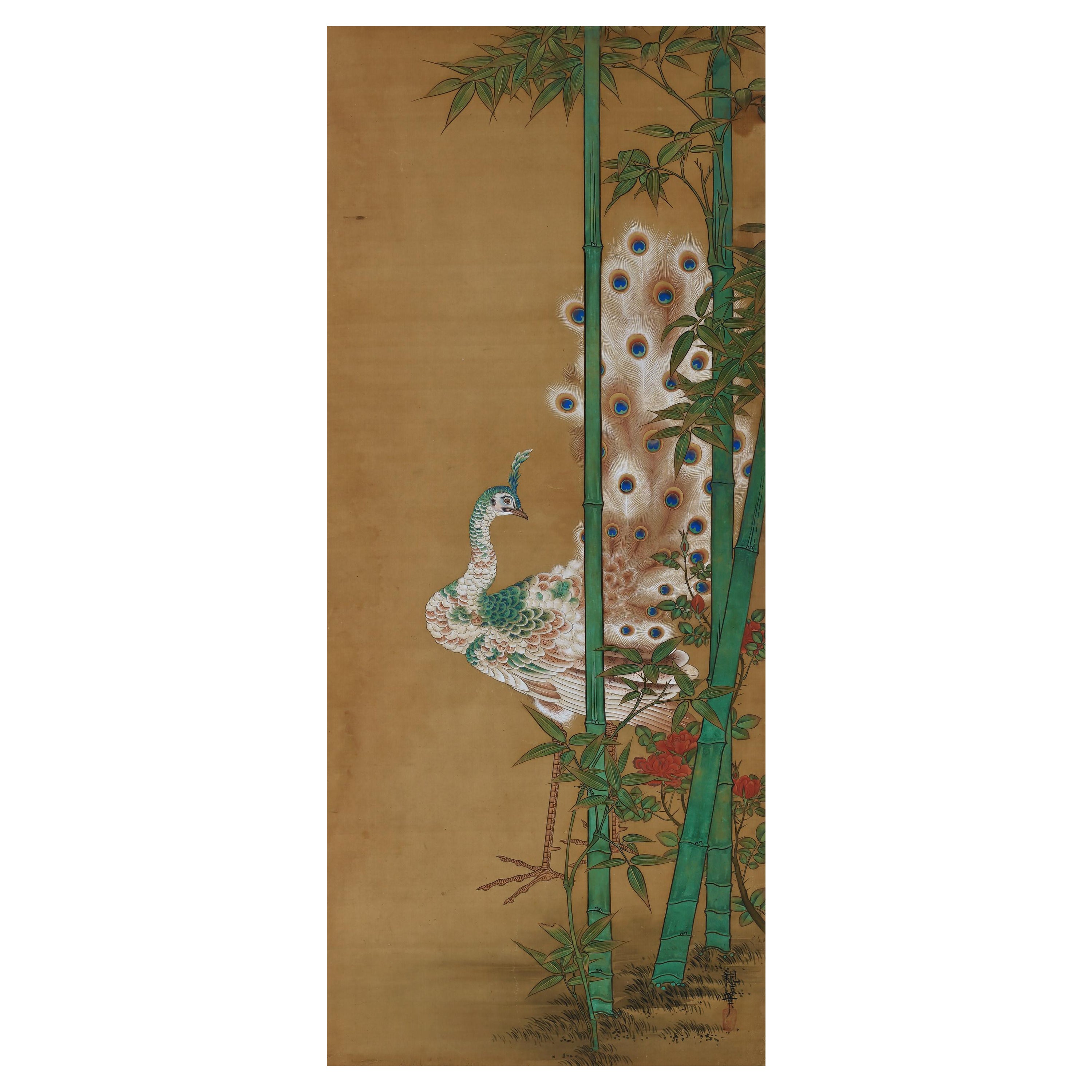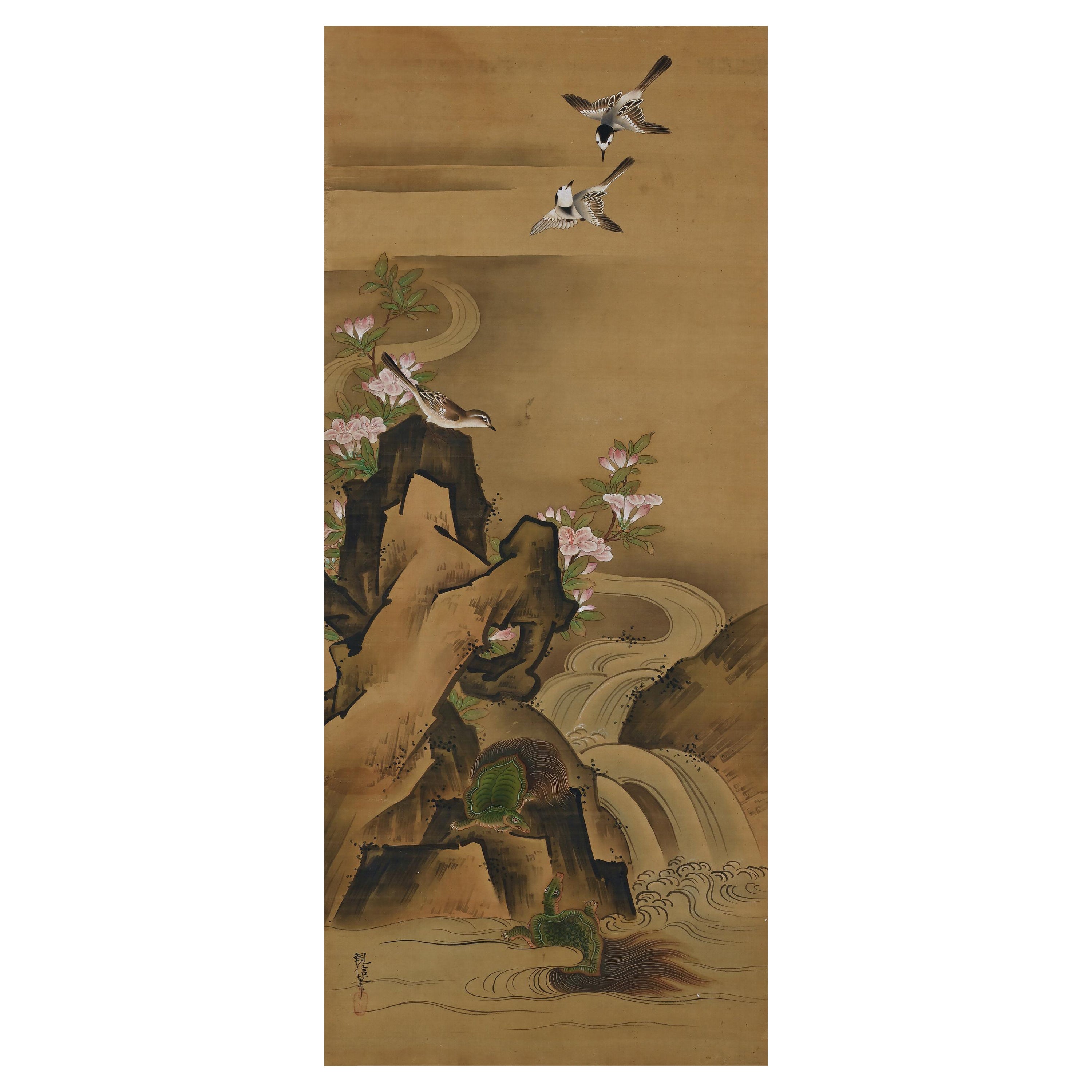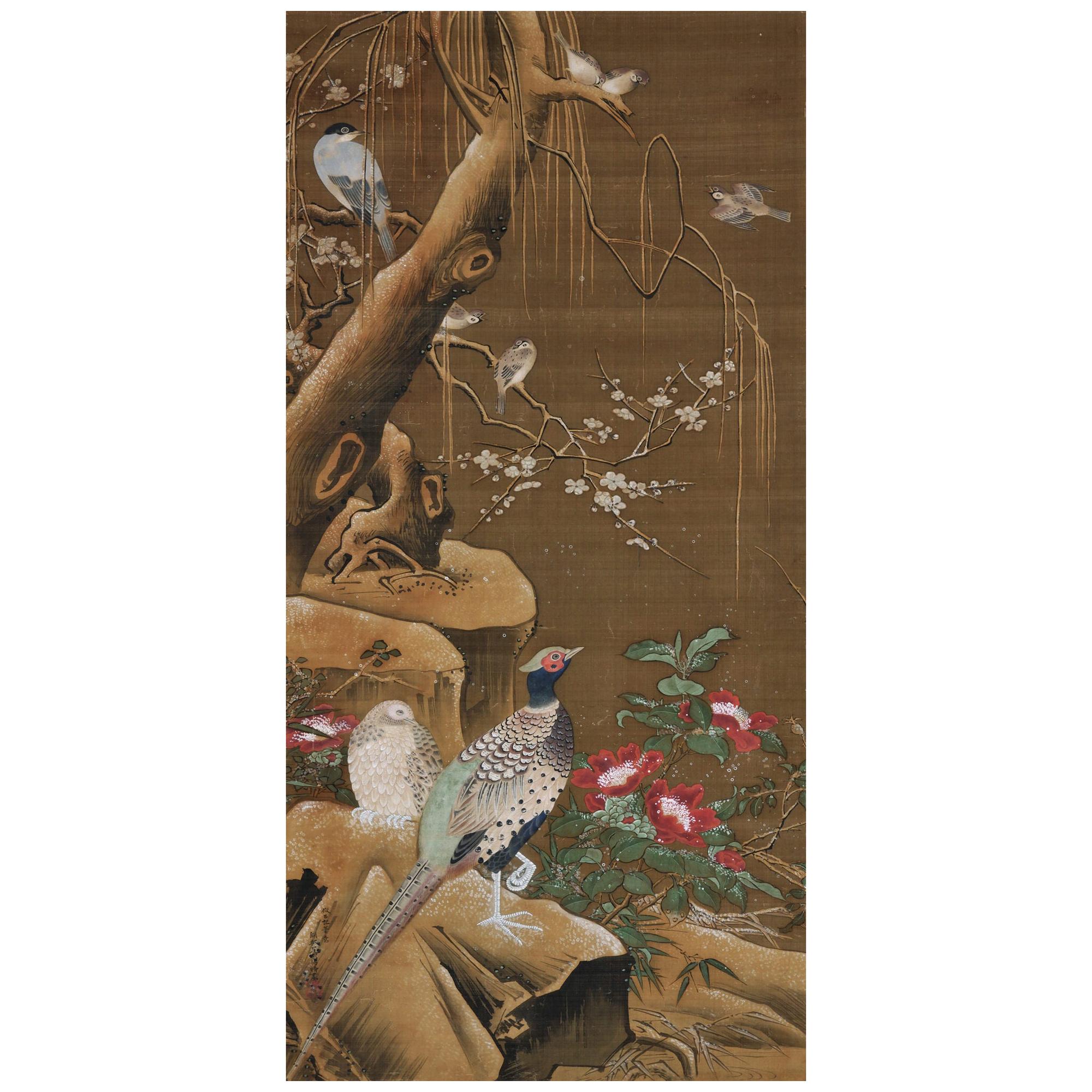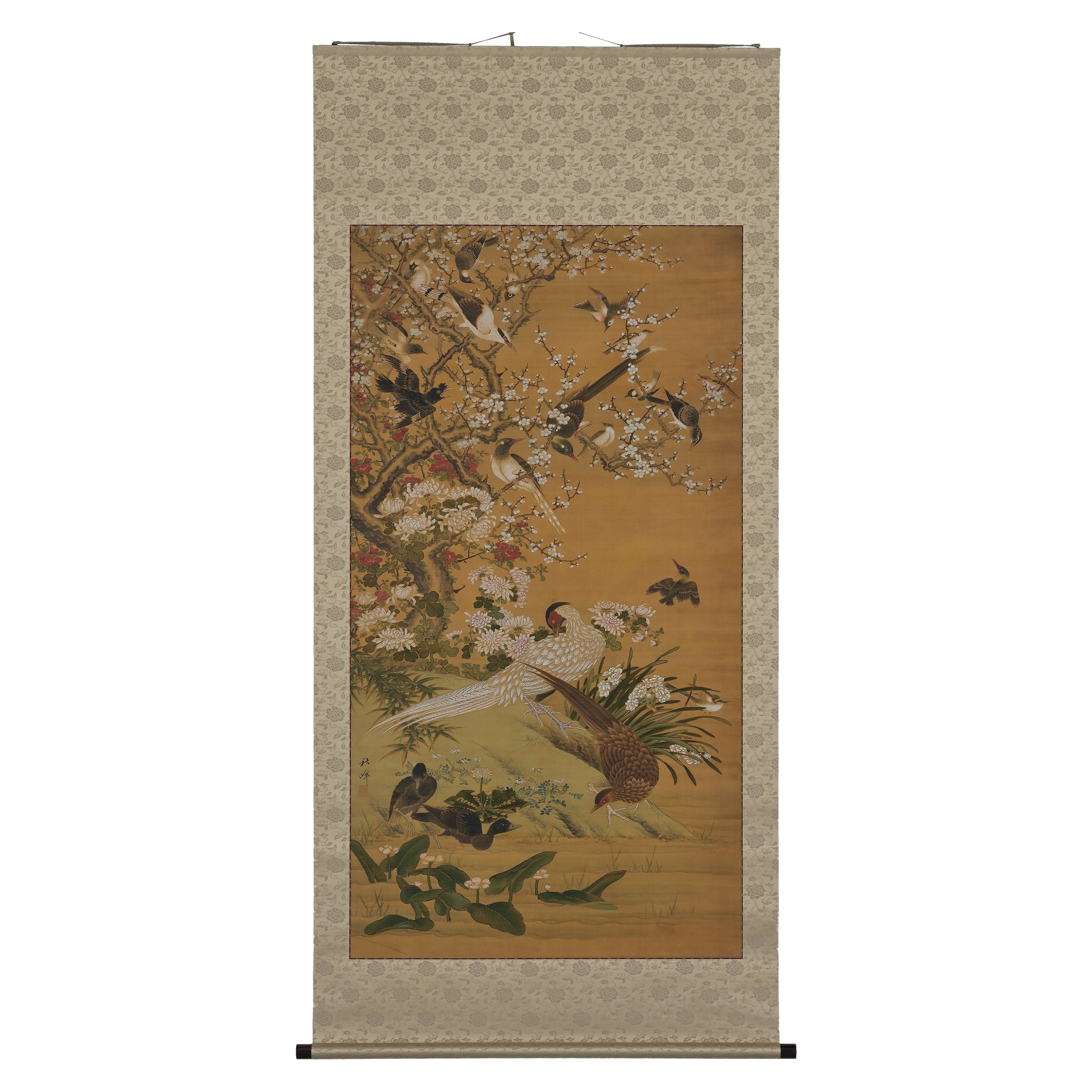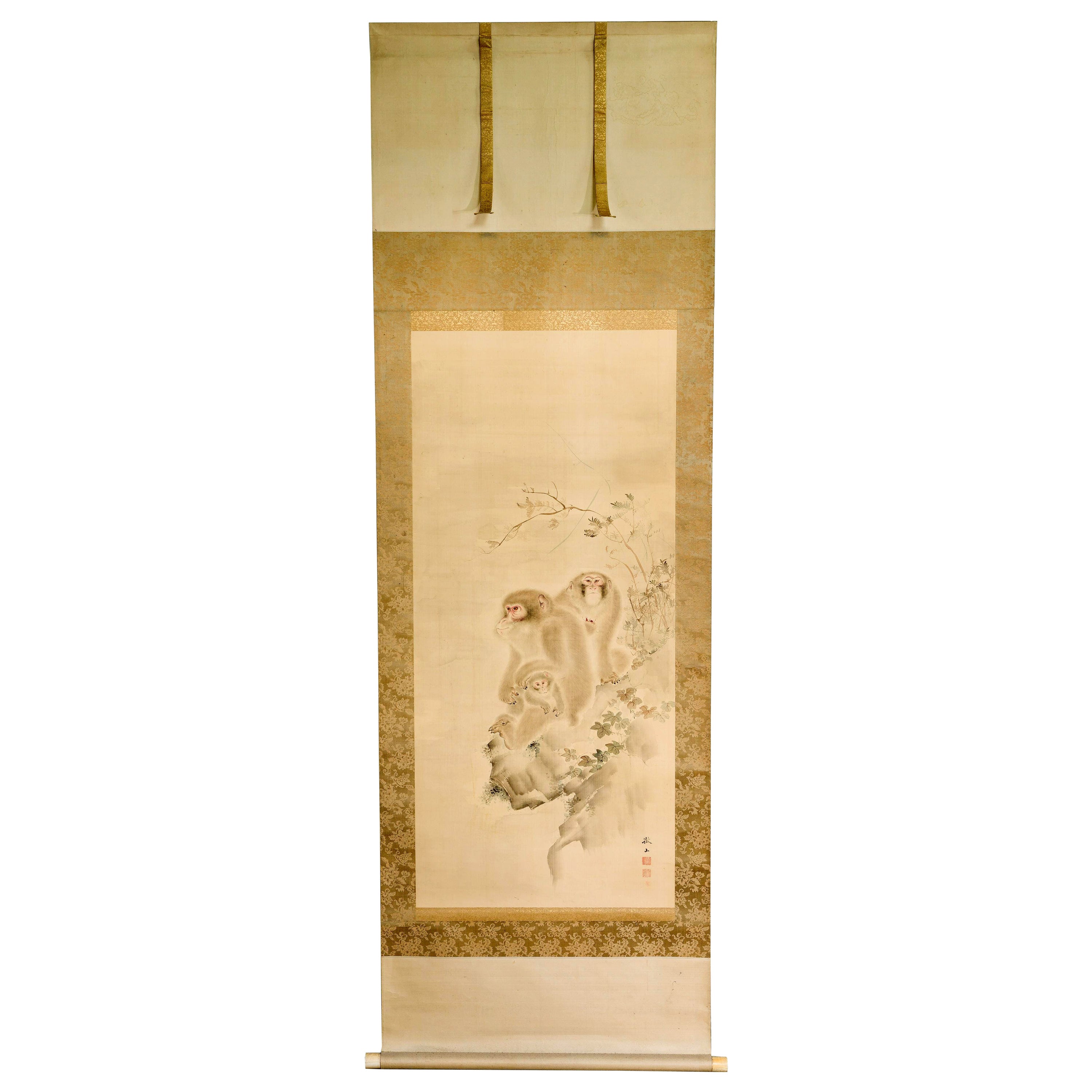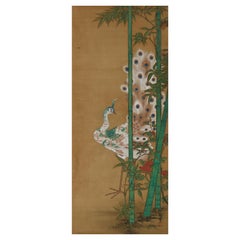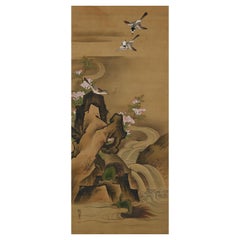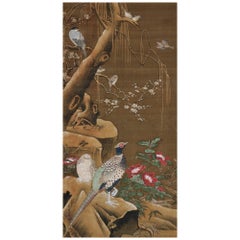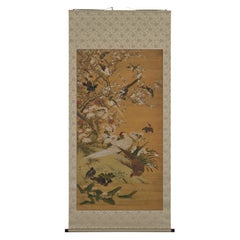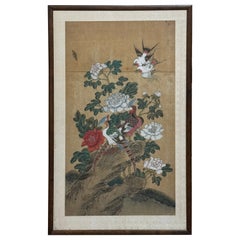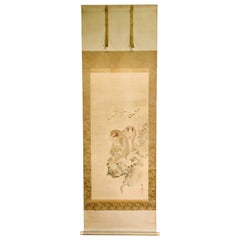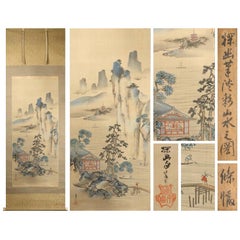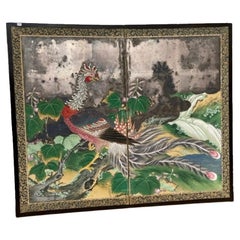Items Similar to 19th Century Japanese Silk Painting by Kano Chikanobu, Phoenix & Paulownia
Want more images or videos?
Request additional images or videos from the seller
1 of 7
19th Century Japanese Silk Painting by Kano Chikanobu, Phoenix & Paulownia
$4,500
£3,385.08
€3,921.46
CA$6,344.07
A$7,055.03
CHF 3,702.95
MX$86,032.67
NOK 46,797.90
SEK 43,874.89
DKK 29,269.28
About the Item
Birds & Flowers of the seasons
Pheasants & Plum in Snow
Unframed painting. Ink, pigment and gofun on silk
Kano Chikanobu 1819-1888
Signature: Chikanobu
Seal: Shateki
Offered here is an unframed ‘kacho-e’ painting by the 19th century Japanese Takamatsu domain painter Kano Chikanobu. There are 8 individual paintings available, which originally would have been part of a set of 12. ‘Kacho-e’ literally means ‘pictures of birds and flowers’. In reality it covers a wide range of natural motifs including birds, fish, insects and small animals in combination with flowers, grasses or trees. The theme has a long history in Japanese painting. It is one of three painting genres, the other two being landscape and figure, which derive from Chinese academic painting classification. As one of the accepted types of painting to be shown in official residences, scenes of birds, flowers and animals were rife with metaphorical reference as well as physical beauty.
In these paintings Chikanobu has made conspicuous use of brilliant pigments and meticulous brushwork. The rocks, water, trees, blossoms, and birds are treated as stylized formal elements in a grand design. All of the components contribute to the patterned effect and tactile richness of the surface. Beyond their highly decorative qualities, the subject of some of the paintings are also an allusion to imperial allegiance; the pheasants are symbolic of bravery and steadfastness, peacocks represent divinity and power, and the phoenix paired with paulownia a just and benevolent ruler. Cranes and turtles symbolize longevity, and the lush, full bloom of the peony flower represents wealth and opulence. Paintings of native Japanese birds and flowers were appreciated primarily for their evocation of the seasons and the traditional poetic emotions associated with them. This is the case with the spring scene of cherry blossoms and birds and the winter scene of narcissus, nandina and sparrows. The rich expression of flower and bird paintings opens our eyes not only to the beauty of the creations of nature, but also to the underlying feelings and emotions of people who cherished this genre of painting in the mid 19th century.
The artist, Kano Chikanobu, was the last official hereditory painter for the Takamatsu feudal domain (present day Kagawa Prefecture). It was his primary duty to supply paintings for his feudal lord. The domain was disbanded in 1871 but not before they fought against the reformist forces at the onset of the Meiji Restoration in 1868. It was a turbulent time in history and the Takamatsu strived unsuccessfully to retain their centuries old way of life.
The paintings have recently been restored in Kyoto utilizing traditional materials and techniques. Fresh backing papers have been applied to the silk in preparation for presentation in a western style frame. Amongst the work carried out during restoration was the cleaning of water damage, repair of holes with replacement silk, reinforcement of cracked silk and touch-ups of the background. There has been no re-painting of the images.
- Dimensions:Height: 46 in (116.84 cm)Width: 19.5 in (49.53 cm)Depth: 0.01 in (0.26 mm)
- Style:Edo (Of the Period)
- Materials and Techniques:
- Place of Origin:
- Period:
- Date of Manufacture:circa 1850
- Condition:Repaired: Recently restored in Kyoto. Traditional craftsmen and techniques. Work included washing, stain removal, repair of damages with replacement silk and reinforcement of cracked silk. The paintings are ready to be presented in a western style frame. Wear consistent with age and use.
- Seller Location:Kyoto, JP
- Reference Number:1stDibs: LU2472325348702
About the Seller
5.0
Recognized Seller
These prestigious sellers are industry leaders and represent the highest echelon for item quality and design.
Established in 2001
1stDibs seller since 2016
70 sales on 1stDibs
Typical response time: 6 hours
- ShippingRetrieving quote...Shipping from: Kyoto, Japan
- Return Policy
Authenticity Guarantee
In the unlikely event there’s an issue with an item’s authenticity, contact us within 1 year for a full refund. DetailsMoney-Back Guarantee
If your item is not as described, is damaged in transit, or does not arrive, contact us within 7 days for a full refund. Details24-Hour Cancellation
You have a 24-hour grace period in which to reconsider your purchase, with no questions asked.Vetted Professional Sellers
Our world-class sellers must adhere to strict standards for service and quality, maintaining the integrity of our listings.Price-Match Guarantee
If you find that a seller listed the same item for a lower price elsewhere, we’ll match it.Trusted Global Delivery
Our best-in-class carrier network provides specialized shipping options worldwide, including custom delivery.More From This Seller
View All19th Century Japanese Silk Painting by Kano Chikanobu, Peacock & Bamboo
Located in Kyoto, JP
Birds & Flowers of the Seasons
Pheasants & Plum in Snow
Unframed painting. Ink, pigment and gofun on silk
Kano Chikanobu 1819-1888
Signature...
Category
Antique Mid-19th Century Asian Edo Paintings and Screens
Materials
Silk
19th Century Japanese Silk Painting by Kano Chikanobu, Turtles & Azalea
Located in Kyoto, JP
Birds & flowers of the seasons
Pheasants & plum in snow
Unframed painting. Ink, pigment and gofun on silk
Kano Chikanobu 1819-1888
Signature...
Category
Antique Mid-19th Century Asian Edo Paintings and Screens
Materials
Silk
Japanese Painting. Bird and Flower. 19th century copy of Lu Ji by Ogata Tomin.
Located in Kyoto, JP
Ogata Tomin (1839 -1895)
Birds in a spring landscape
Ink and colour on silk.
Inscription reads:
“Copy of Lu Ji, painted with heartfelt appreciation”
“Painted by Tomin Ogat...
Category
Antique Late 19th Century Japanese Ming Paintings and Screens
Materials
Silk
19th Century Japanese Scroll Painting, Birds & Flowers of the Four Seasons
Located in Kyoto, JP
Birds and flowers of the four seasons
Early to mid-19th century
Ink, pigment and gofun on silk
Unidentified artist
Signature: S...
Category
Antique 1830s Japanese Edo Paintings and Screens
Materials
Silk
Japanese Scroll Painting, 19th Century Chinese Pheasants by Yoshizawa Setsuan
Located in Kyoto, JP
Chinese Pheasants
Yoshizawa Setsuan (1809-1889)
Hanging scroll, ink and color on silk.
Painting inscription: Setsuan Houyou
Upper seal: Y...
Category
Antique Mid-19th Century Asian Meiji Paintings and Screens
Materials
Silk
1844 - Chichi, Japanese Scroll Painting. Colour on Silk
Located in Kyoto, JP
Mother’s Breast (Chichi) 1844
Hanging scroll. Ink, pigments and gofun on silk.
Inscription:
Kouka era, dragon year, late winter, painted by Shozan Yashou
Artist’ seals:
...
Category
Antique 1840s Japanese Edo Paintings and Screens
Materials
Silk
You May Also Like
Chinese "Birds and Peony" Ink and Color on Silk Painting, Qing Dynasty, China
Located in Austin, TX
A charming Chinese "Birds and Peony" painting, ink and color on silk, framed and glazed, Qing Dynasty, late 19th century, China.
The delightful and colorful painting features a scen...
Category
Antique Late 19th Century Chinese Qing Paintings and Screens
Materials
Metal
Japanese Silk Scroll Painting of Moneys Edo Period Mori Tetsuzan
Located in Atlanta, GA
A Japanese mounted vertical hanging scroll painting by Mori Tetsuzan (Japanese, 1775-1841) circa 19th century Edo period. The watercolor and ink on silk ...
Category
Antique 19th Century Japanese Japonisme Paintings and Screens
Materials
Silk, Paper
Lovely 17th-18th Century Scroll Painting Japan Artist Kano Soyu Painted
Located in Amsterdam, Noord Holland
It is a work that is said to have been drawn by Kano Soyu as you can see.
It is a picture of the light-colored Sansui map carefully drawn to the smallest detail, and the
towering m...
Category
Antique 17th Century Japanese Edo Paintings and Screens
Materials
Silk
$3,008 Sale Price
20% Off
Japanese Two-Panel Phoenix Screen, Edo Period, Ca. 1850
Located in New York, NY
Japanese Two-Panel Phoenix Screen, Edo Period, Ca. 1850
Japanese Edo Period (1603-1868)
DIMENSIONS
Height: 24 inches
Width: 28 inches
Category
Antique 1850s Japanese Japonisme Paintings and Screens
Materials
Wood
Japanese Antiques Takeya-machi embroidery, bird picture, hanging scroll
Located in Niiza, JP
Embroidery, scroll tip: wood
Embroidery Size: 320 (W) x 760 (H) [mm],
Overall: 470 (W) x 1650 (H) [mm]
Box size: 80×70×630㎜ 800g
Takeya-machi embroidery has a long history.
When T...
Category
Antique Early 19th Century Japanese Textiles
Materials
Paper
Japanese Edo Period Painting Scroll Ônishi Chinnen '1792 - 1851' Artist Signed
Located in Amsterdam, Noord Holland
Ônishi Chinnen (1792 - 1851) Schilpadden en bamboo
Rolschildering / scroll op papier, benen rollers. B 125.7 x 48.9 / 179.5 x 59.5 cm
125.7 x 48.9 / 179.5 x 59.5 cm.
Category
Antique Mid-19th Century Japanese Meiji Paintings and Screens
Materials
Silk
$1,480 Sale Price
20% Off
More Ways To Browse
Antique Bird Painting
Watered Silk
Chinese Silk Paintings
Bird Silk Art
Antique Silk Screen Painting
Traditional Japanese Painting
Chinese Painting On Silk
Asian Antique Landscape Paintings
Japanese Phoenix
Asian Bird Paintings
Pair Of Japanese Paintings
19th Century Ink Wells
Japanese Insect
Chinese Bird Painting
Asian Silk Art Birds
Chinese Bird And Flowers Painting
Japanese Silk Painting Ink
Tree Of Life Silk
